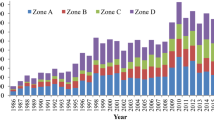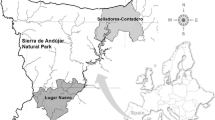Abstract
We have estimated the number of sika deer, Cervus nippon, in Hokkaido, Japan, with the aim of developing a management program that will reduce the level of agricultural damage caused by these deer. A population index that is defined by the population divided by the population of 1993 is first estimated from the data obtained during a spotlight survey. A generalized linear mixed model (GLMM) with corner point constraints is used in this estimation. We then estimate the population from the index by evaluating the response of index to the known amount of harvest, including hunting. A stage-structured model is used in this harvest-based estimation. It is well-known that estimates of indices suffer from large observation errors when the probability of the observation fluctuates widely; therefore, we apply state-space modeling to the harvest-based estimation to remove the observation errors. We propose the use of Bayesian estimation with uniform prior-distributions as an approximation of the maximum likelihood estimation, without permitting an arbitrary assumption that the parameters fluctuate following prior-distributions. We are able to demonstrate that the harvest-based Bayesian estimation is effective in reducing the observation errors in sika deer populations, but the stage-structured model requires many demographic parameters to be known prior to running the analyses. These parameters cannot be estimated from the observed time-series of the index if there is insufficient data. We then construct a univariate model by simplifying the stage-structured model and show that the simplified model yields estimates that are nearly identical to those obtained from the stage-structured model. This simplification of the model simultaneously clarifies which parameter is important in estimating the population.






Similar content being viewed by others
References
Aitkin M, Francis B, Hinde J (2005) Statistical modelling in GLIM4, 2nd edn. Oxford University Press, Oxford
Akaike H (1973) Information theory and an extension of the maximum likelihood principle. In: Petrov BN, Csadki F (eds) 2nd Int Symp information Theory. Akademiai Kiado, Budapest, pp 267–281
Akaike H (2007) AIC and Bayesian model. In: Higuchi T (ed) Mathematical statistics reveals the hidden future (in Japanese). Tokyo Denki University Press, Tokyo, pp 8–10
Amari S (2007) Akaike information criterion, AIC: concepts and new development. In: Murota K, Tuchiya T (eds) Akaike information criterion (in Japanese). Kyoritu, Tokyo, pp 52–78
Anderson DR (2001) The need to get the basics right in wildlife field studies. Wildl Soc Bull 29:1294–1297
Anderson DR (2003) Response to Engeman: index values rarely constitute reliable information. Wildl Soc Bull 31:288–291
Bayes T (1763) An essay towards solving a problem in the doctrine of chances. Philos Trans 53:370–418
Brooks SP, Gelman A (1998) General methods for monitoring convergence of iterative simulations. J Comput Graph Stat 7:434–455
Buckland ST, Newman KB, Thomas L, Koesters NB (2004) State-space models for the dynamics of wild animal populations. Ecol Model 171:157–175
Calder C, Lavine M, Müller P, Clark JS (2003) Incorporating multiple sources of stochasticity into dynamic population models. Ecology 84:1395–1402
Carlin BP, Louis TA (2000) Bayes and empirical Bayes methods for data analysis 2nd edn. Chapman& Hall/CRC, Boca Raton
Clark JS (2005) Why environmental scientists are becoming Bayesians. Ecol Lett 8:2–14
Clark JS (2007) Models for ecological data: an introduction. Princeton University Press, Princeton
Clark JS, Bjørnstad ON (2004) Population time series: process variability, observation errors, missing values, lags, and hidden states. Ecology 85:3140–3150
Clark JS, Gelfand AE (eds) (2006) Hierarchical modelling for the environmental sciences: statistical methods and applications. Oxford University Press, Oxford
Cowles MK, Carlin BP (1996) Marcov chain Monte Carlo convergence diagnostics: a comparative review. J Am Stat Assoc 91:883–904
Diggle PJ, Heagerty PJ, Liang K-Y, Zeger SL (2002) Analysis of longitudinal data, 2nd edn. Oxford University Press, Oxford
Efron B (1998) R. A. Fisher in the 21st century. Statist Sci 13:95–122
Ellison AM (2004) Bayesian inference for ecologists. Ecol Lett 7:509–520
Fisher RA (1922) On the mathematical foundations of theoretical statistics. Philos Trans R Soc Lond A 222:309–368
Gamerman D (1997) Markov chain Monte Carlo: stochastic simulation for Bayesian inference. CRC, Boca Raton
Gross K, Craig BA, Hutchison WD (2002) Bayesian estimation of a demographic matrix model from stage-frequency data. Ecology 83:3285–3298
Hokkaido Institute of Environmental Sciences (1994) Distribution of sika deer and brown bear on Hokkaido (in Japanese). Hokkaido Institute of Environmental Sciences, Sapporo
Hokkaido Institute of Environmental Sciences (1995) Results of a survey related to sika deer and brown bear on Hokkaido (in Japanese). Hokkaido Institute of Environmental Sciences, Sapporo
Hokkaido Institute of Environmental Sciences (1997) Results of a survey related to sika deer and brown bear in Hokkaido. III (in Japanese). Hokkaido Institute of Environmental Sciences, Sapporo
Hubbard R, Bayarri MJ (2003) Confusion over measures of evidence (p’s) versus errors (α’s) in classical statistical testing. Am Stat 57:171–178
Inukai T (1933) Review on extirpation of wolves in Hokkaido (in Japanese). Shokubutsu oyobi Dôbutsu (Bot Zool) 1:1091–1098
Kaji K (2001) Population characteristics of sika deer in the Ashoro area. In: Kaji K (ed) Study on the conservation and management of sika deer in Hokkaido, 1996–2000 (in Japanese). Hokkaido Institute of Environmental Sciences, Sapporo, pp 32–41
Kaji K, Koizumi T, Ohtaishi N (1988) Effects of resource limitation on the physical and reproductive condition of sika deer on Nakanoshima Island, Hokkaido. Acta Theriol 33:187–208
Kaji K, Matsuda H, Uno H, Hirakawa H, Tamada K, Saitoh T (1998) Sika deer management in Hokkaido (in Japanese). Honyurui Kagaku (Mamm Sci) 38:301–313
Kaji K, Okada H, Yamanaka M, Matsuda H, Yabe T (2004) Irruption of a colonizing sika deer population. J Wild Manage 68:889–899
Kitagawa G (1996a) Monte Carlo filter and smoother for non-Gaussian nonlinear state space models. J Comput Graph Stat 5:1–25
Kitagawa G (1996b) On Monte Carlo filter and smoother (in Japanese with English summary). Proc Inst Stat Math 44:31–48
Kitagawa G (2007) Information criterion and statistical modeling. In: Murota K, Tuchiya T (eds) Akaike information criterion (in Japanese). Kyoritu, Tokyo, pp 79–109
Konishi S, Kitagawa G (2004) Information criterion (in Japanese). Asakura, Tokyo
Kubo T, Kasuya E (2006) An introduction to mixed models in ecology (in Japanese). Jpn J Ecol 56:181–190
Littell RC, Milliken GA, Stroup WW, Wolfinger RD (2006) SAS for mixed models, 2nd edn. SAS Institute, Cary, NC
Martínez-Abraín A, Oro D, Forero MG, Conesa D (2003) Modeling temporal and spatial colony-site dynamics in a long-lived seabird. Popul Ecol 45:133–139
Matsuda H, Kaji K, Uno H, Hirakawa H, Saitoh T (1999) A management policy for sika deer based on sex-specific hunting. Res Popul Ecol 41:139–149
Matsuda H, Uno H, Tamada K, Kaji K, Saitoh T, Hirakawa H, Kurumada T, Fujimoto T (2002) Harvest-based estimation of population size for Sika deer on Hokkaido Island, Japan. Wildl Soc Bull 30:1160–1171
McCarthy MA (2007) Bayesian methods for ecology. Cambridge University Press, Cambridge
McCullagh P, Nelder JA (1989) Generalized linear models, 2nd edn. Chapman and Hall, London
McCulloch CE (2003) Generalized linear mixed models. Institute of Mathematical Statistic, Beachwood
McCulloch CE, Searle SR (2001) Generalized, linear, and mixed models. Wiley, New York
Meyer R, Millar RB (1999) BUGS in Bayesian stock assessment. Can J Fish Aquat Sci 56:1078–1086
Millar RB, Meyer R (2000) Bayesian state-space modeling of age-structured data: fitting a model is just the beginning. Can J Fish Aquat Sci 57:43–50
Minotani C (2003) Handbook of statistical distributions (in Japanese). Asakura, Tokyo
Nagata J, Masuda R, Kaji K, Kaneko M, Yoshida MC (1998) Genetic variation and population structure of the Japanese sika deer (Cervus nippon) in Hokkaido Island, based on mitochondrial D-loop sequences. Mol Ecol 7:871–877
Newman KB, Buckland ST, Lindley ST, Thomas L, Fernández C (2006) Hidden process models for animal population dynamics. Ecol Appl 16:74–86
Neyman J (1934) On the two different aspects of the representative method. J R Stat Soc A 97:558–606
Punt AE (2003) Extending production models to include process error in the population dynamics. Can J Fish Aquat Sci 60:1217–1228
Saitoh T, Stenseth NC, Viljugrein H, Kittilsen MO (2003) Mechanisms of density dependence in fluctuating vole populations: deducing annual density dependence from seasonal processes. Popul Ecol 45:165–173
Salsburg D (2001) The lady tasting tea: how statistics revolutionized science in the twentieth century. Freeman, New York
Shibamura R (2004) Statistical theory of R. A. Fisher (in Japanese). Kyushu University Press, Fukuoka
Smith BJ (2005) Bayesian output analysis program (BOA) version 1.1 user’s manual. Available at: http://www.public-health.uiowa.edu/boa/
Spiegelhalter DJ, Best NG, Carlin BP, van der Linde A (2002) Bayesian measures of model complexity and fit (with discussion). J Roy Stat Soc B 64:583–640
Spiegelhalter DJ, Thomas A, Best N, Lunn D (2003) WinBUGS user manual, version 1.4. MRC Biostatistics Unit, Cambridge
Stenseth NC, Viljugrein H, Saitoh T, Hansen TF, Kittilsen MO, Bølviken E, Glöckner F (2003) Seasonality, density dependence and population cycles in Hokkaido voles. Proc Natl Acad Sci USA 100:11478–11483
Stone M (1979) Comments on model selection criteria of Akaike and Schwarz. J Roy Stat Soc B 41:276–278
Takatsuki S, Suzuki K, Suzuki I (1994) A mass-mortality of Sika deer on Kinkazan Island, northern Japan. Ecol Res 9:215–223
Uno H, Yokoyama M, Takahashi M (1998) Winter mortality pattern of Sika deer (Cervus nippon yesoensis) in Akan National Park, Hokkaido (in Japanese with English summary). Honyurui Kagaku (Mamm Sci) 38:233–246
Uno H, Kaji K, Saitoh T, Matsuda H, Hirakawa H, Yamamura K, Tamada K (2006) Evaluation of relative density indices for sika deer in eastern Hokkaido, Japan. Ecol Res 21:624–632
de Valpine P (2003) Better inferences from population-dynamics experiments using Monte Carlo state-space likelihood methods. Ecology 84:3064–3077
de Valpine P, Hastings A (2002) Fitting population models incorporating process noise and observation error. Ecol Monogr 72:57–76
de Valpine P, Hilborn R (2005) State-space likelihoods for nonlinear fisheries time-series. Can J Fish Aquat Sci 62:1937–1952
Venables WN, Ripley BD (2002) Modern applied statistics with S, 4th edn. Springer, New York
Viljugrein H, Stenseth NC, Smith GW, Steinbakk GH (2005) Density dependence in North American ducks. Ecology 86:245–254
Williams CK, Ives AR, Applegate RD (2003) Population dynamics across geographical ranges: time-series analyses of three small game species. Ecology 84:2654–2667
Yamamura K, Yokozawa M, Nishimori M, Ueda Y, Yokosuka T (2006) How to analyze long-term insect population dynamics under climate change: 50-year data of three insect pests in paddy fields. Popul Ecol 48:31–48
Acknowledgments
We thank Dr. Y. Iwasa for reviewing the manuscript. We also thank anonymous reviewers for their comments that improved the manuscript greatly. This work has been supported by a Grant-in-Aid for Scientific Research of JSPS to H.Y.
Author information
Authors and Affiliations
Corresponding author
Electronic supplementary material
Below is the link to the electronic supplementary material.
Rights and permissions
About this article
Cite this article
Yamamura, K., Matsuda, H., Yokomizo, H. et al. Harvest-based Bayesian estimation of sika deer populations using state-space models. Popul Ecol 50, 131–144 (2008). https://doi.org/10.1007/s10144-007-0069-x
Received:
Accepted:
Published:
Issue Date:
DOI: https://doi.org/10.1007/s10144-007-0069-x




